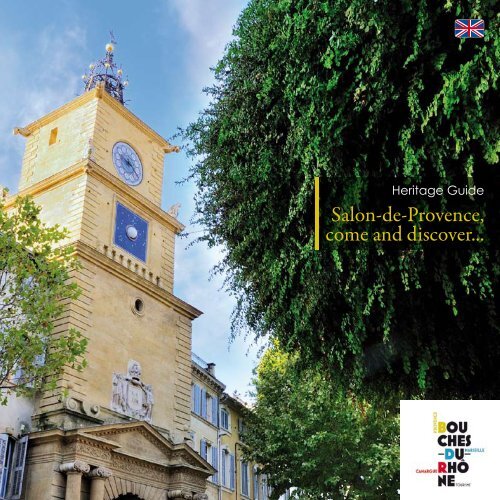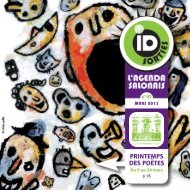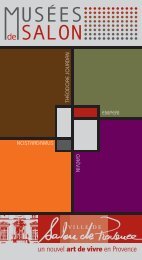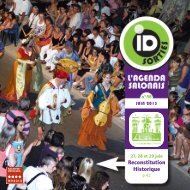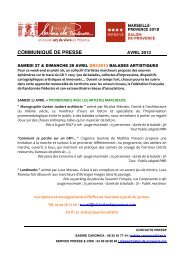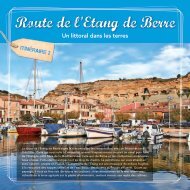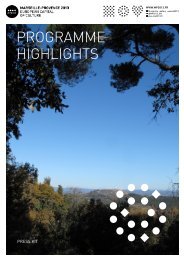Direct download - Salon de Provence
Direct download - Salon de Provence
Direct download - Salon de Provence
Create successful ePaper yourself
Turn your PDF publications into a flip-book with our unique Google optimized e-Paper software.
SALON'S<br />
ORIGINS<br />
�e region was �rst settled by the Ligurians, who occupied the highest point of the Cuech Valley. �e remains of<br />
this �rst settlement can still be seen, on the road to the village of Aurons.<br />
�e Town of <strong>Salon</strong><br />
Although the region had long been inhabited, the name of Villa Sallone (the town of <strong>Salon</strong>) did not appear in<br />
writing until 871. An inventory listing the assets belonging to Rostang, then Archbishop of Arles, mentions that<br />
he owned land in the <strong>Salon</strong> area. �e Archbishop of Arles, to whom the Emperor of the Holy Roman Empire<br />
<strong>de</strong>legated power, administered Arles, its surrounding districts, and <strong>Salon</strong>. �e lands were not o�cially part of<br />
<strong>Provence</strong>, and as such, retained a number of privileges until it became part of France in 1481.<br />
�e town was known as Sallon <strong>de</strong> Crau, <strong>Salon</strong> being spelt with a double l until a mistake in the engraving on the<br />
pe<strong>de</strong>stal of a bust assigned the name one single l in 1784. �e council adopted the new spelling and the town<br />
�nally became <strong>Salon</strong>-<strong>de</strong>-<strong>Provence</strong> in 1918.
MAP OF<br />
TOWN CENTER<br />
Fountains<br />
1<br />
2<br />
3<br />
4<br />
5<br />
6<br />
7<br />
8<br />
9<br />
10<br />
Robert <strong>de</strong> Lamanon fountain<br />
Adam <strong>de</strong> Craponne fountain<br />
Fountain of the Place <strong>de</strong> la Révolution<br />
Fountain and Washhouse<br />
Mossy Fountain<br />
Puits du Mouton Fountain<br />
Louis Blanc Fountain<br />
Three Fountains<br />
Multi-Jet Fountain<br />
Portail Coucou Fountain<br />
19th Century Heritage<br />
1<br />
2<br />
3<br />
4<br />
5<br />
6<br />
7<br />
8<br />
9<br />
10<br />
Arts & Tra<strong>de</strong>s Association<br />
Armand Theatre<br />
Roche Mansion<br />
Louanes Chateau<br />
Ravoire Mansion<br />
Bourgue Mansion<br />
Law Courts<br />
Cou<strong>de</strong>rc Mansion/Vignoli Clinic<br />
Marius Fabre Soap Factory<br />
Rampal Latour Soap Factory<br />
Statues<br />
1<br />
2<br />
3<br />
4<br />
5<br />
6<br />
Monument to the Dead<br />
Bust of Antoine Blaise Crousillat<br />
Camille Pelletan<br />
Adam <strong>de</strong> Craponne<br />
Nostradamus I<br />
Nostradamus II<br />
Monuments<br />
1<br />
2<br />
3<br />
4<br />
5<br />
6<br />
7<br />
8<br />
9<br />
10<br />
11<br />
12<br />
Empéri Castle<br />
Church of Saint-Michel<br />
Clock Tower<br />
Collegiate Church of Saint-Laurent<br />
Bourg-Neuf Tower<br />
Town Hall<br />
House of Nostradamus<br />
Chapel Door of the Capucine Convent<br />
Door of the Ursuline Convent<br />
Crousillat House<br />
Tower of Galagaspe/Babylon<br />
Old Silk Factory<br />
Other Sights<br />
1 Jean XXIII Square<br />
2 War Memorial - The Sublime Awakening<br />
3 Mock Renaissance Window<br />
4 Bandstand<br />
5 Place du Général <strong>de</strong> Gaulle<br />
6 Aeroplane Wing<br />
7 Nostradamus Fresco<br />
8 Patrouille <strong>de</strong> France Roundabout<br />
9 Jean Moulin Memorial<br />
10 Nostradamus Statue<br />
Museums<br />
Office <strong>de</strong> Tourisme Édition © Janvier 2012 - Toute reproduction même partielle <strong>de</strong> ce plan est interdite.<br />
O<br />
SO<br />
NO<br />
N<br />
S<br />
NE<br />
SE<br />
E<br />
BVD DES BLAZOTS<br />
IMP. LANIER<br />
RUE PIERRE-PAUL<br />
AVENUE ÉMILE ZOLA<br />
P<br />
BVD DANTON<br />
BOULEVARD DES PRINCES<br />
RUE THÉODORE AUBANEL<br />
R. DES HIRONDELLES<br />
<strong>de</strong> tourisme<br />
GARE<br />
P<br />
RUE CHARLES SERRE<br />
RUE DU C. SIBOUR<br />
RUE GUSTAVE GAUBERT<br />
RUE DE L'EISSAME<br />
RUE DU RHÔNE<br />
7<br />
R. H. AMIEL<br />
RUE DU DOCTEUR MOURET<br />
RUE DE LA CAMARGUE<br />
AVENUE P. BOURRET<br />
8<br />
9<br />
RUE SAINT-LAZARE<br />
RUE<br />
IMP<br />
BOULEVAR<br />
RUE AUGUSTE GIRARD<br />
6<br />
RUE ANTHIME R<br />
RUE BO
DU RHÔNE<br />
ASSE OLIVIER<br />
AVOIRE<br />
NNEFOY<br />
R. DE LA PENNE<br />
RUE FÉLIX PYAT<br />
R. DES LOUANES<br />
RUE JEAN MARINI<br />
10<br />
R. DU C. GUIBERT<br />
RUE FÉLIX PYAT<br />
D GEORGES CLÉMENCEAU<br />
RUE SAINT- FRANÇOIS<br />
RUE LABADIE<br />
RUE SÉNÈQUE<br />
BOULEVARD DE LA RÉPUBLIQUE<br />
BOULEVARD MARÉCHAL FOCH<br />
RUE CÉSAR BOSSY<br />
RUE DU<br />
RAPLOU<br />
RUE GUTENBERG<br />
BOULEVARD ARISTIDE BRIAND<br />
Bibliothèque<br />
Municipale<br />
R. DU 4 SEPTEMBRE<br />
5<br />
Auditorium<br />
STADE D'HONNEUR<br />
4<br />
PARC<br />
DE LA<br />
LÉGION<br />
D'HONNEUR<br />
P<br />
AVENUE DE LA LIBERTÉ<br />
Espace<br />
Charles<br />
Trenet<br />
Vers RN 538<br />
R. DES DROITS DE L'HOMME<br />
BOULEVARD DAVID<br />
RUE AUBLET<br />
RUE DES FRÈRES J. ET R. KENNEDY<br />
R. DES<br />
CORDELIERS R. DES FRÈRES JOURDAN<br />
RUE CHANZY<br />
PLACE<br />
JULES<br />
MORGAN<br />
RUE D'HOZIER<br />
BVD LÉOPOLD COREN<br />
BOULEVARD NOSTRADAMUS<br />
3<br />
P<br />
9<br />
RUE SUFFREN<br />
2<br />
P<br />
9<br />
5<br />
RUE JEAN COCTEAU<br />
CIMETIÈRE<br />
5<br />
PLACE DU<br />
GÉNÉRAL<br />
DE GAULLE<br />
PLACE<br />
E. PELLETAN<br />
RUE MASSENET<br />
2<br />
BOULEVARD VICTOR JOLY<br />
6<br />
R. DES FILEUSES<br />
DE SOIE<br />
PLACE DES<br />
MARTYRS<br />
1<br />
8<br />
RUE EXPILLY<br />
RUE THÉODORE JOURDAN<br />
COURS CAMILLE PELLETAN<br />
12<br />
4<br />
R. ARLATAN<br />
R. DU<br />
PORTALET<br />
R. DE LA<br />
GUÉRITTE<br />
RUE TREZ-CASTEL<br />
R. DE LA<br />
TEINTURE<br />
RUE MOULIN D'ISNARD<br />
RUE<br />
FOUR<br />
BOULEVAR D JEAN JAURÈS<br />
RUE COUTELLERIE<br />
RUE PALAMARD<br />
R. DE<br />
LA TOUR<br />
MONTÉE DE<br />
LA GLACIÈRE<br />
11<br />
PLACE<br />
GALAGASPE<br />
PLACE<br />
JEAN<br />
XXIII<br />
BVD LOUIS PASQUET<br />
PLACE<br />
L. BLANC<br />
RUE PONSARD<br />
PLACE<br />
CROUSILLAT<br />
RUE DE l'HORLOGE<br />
CHEMIN DE MIREIO<br />
MONTÉE<br />
A.VIALLAT<br />
PLACE<br />
DE LA<br />
FERRAGE<br />
BOULEVARD DAVID<br />
RUE DES JARDINS<br />
R. DU<br />
GRAND FOUR<br />
R.BEAUVEZET<br />
RUE CONCERT<br />
R. TRONC<br />
RUE DU DOCTEUR C.ROUX<br />
RUE MARÉCHAL JOFFRE<br />
RUE FOUR<br />
BOURG NEUF<br />
RUE DU BOURG NEUF<br />
PLACE<br />
LATIL<br />
RUE<br />
PORTE COUCOU<br />
COURS CARNOT COURS VICTOR HUGO<br />
R. MENDÈS FRANCE<br />
RUE PONTIS<br />
PLACE DU<br />
PUITS DU<br />
MOUTON<br />
6<br />
4<br />
RUE MALESPINE<br />
4<br />
1<br />
2<br />
3<br />
5<br />
P<br />
7<br />
10<br />
3<br />
RUE<br />
NOSTRADAMUS<br />
PLACE DE<br />
L'ANCIENNE HALLE<br />
PLACE<br />
7 SAINT-<br />
MICHEL<br />
1<br />
3<br />
6<br />
PLACE<br />
FARREYROUX<br />
7<br />
CODOLET<br />
2<br />
PLACE<br />
DES<br />
CENTURIES<br />
MONTÉE DU PUECH<br />
PLACE<br />
DE LA<br />
RÉVOLUTION<br />
R. DE LA CLAUSTRE<br />
R. DE L'EMPÉRI<br />
3<br />
RUE BASTONENQ<br />
R. J. BLANCHARD<br />
PLACE<br />
PASSELAIGUE<br />
PLACE<br />
NEUVE<br />
P<br />
PLACE<br />
CATHERINE<br />
DE<br />
MÉDICIS<br />
MONTÉE DU<br />
PUECH<br />
RUE RAYNAUD D'URSULE<br />
8<br />
5<br />
8<br />
6<br />
RUE D E VERDUN<br />
COURS GIMON<br />
PLACE<br />
PORTE<br />
COUCOU<br />
4<br />
2<br />
1<br />
RUE DES MOULINS<br />
8<br />
RUE LAFAYETTE<br />
R. DES<br />
URSULINES<br />
10<br />
8<br />
10<br />
CHEMIN DU PILO N BLANC<br />
R. PAUL CONTE DEVOLX<br />
BOULEVARD LAMARTINE<br />
RUE DES C ASERNES<br />
RUE A. MOUTIN<br />
R. DES<br />
ÉCOLES<br />
BOULEVARD DES CAPUCINS<br />
P<br />
BVD DES CAPUCINS<br />
BVD F. MISTRAL<br />
1<br />
9<br />
PLACE<br />
GAMBETTA<br />
Vers MARSEILLE<br />
R. JANICOT<br />
P<br />
IMP. GRÉGOIRE
FOUNTAINS<br />
1<br />
Robert <strong>de</strong> Lamanon (1752-1787)<br />
Cours Gimon<br />
This fountain was erected in 1859 in honour of the naturalist and geologist, Robert <strong>de</strong> Lamanon. Topped by a<br />
<strong>de</strong>corative metal vase, it features sculptures of plantlife and on the si<strong>de</strong> where the water spouts is the face of a woman.<br />
The water is sourced from Les Aubes on the outskirts of the town.<br />
First restored in 1988, the lower part of the fountain was reworked in 2006 when the streets in the town centre were<br />
restored.<br />
Adam <strong>de</strong> Craponne (1526-1576)<br />
Place <strong>de</strong> l'hôtel <strong>de</strong> ville<br />
This fountain was created by the Aix sculptor Marius Ramus in honour of Adam <strong>de</strong> Craponne, the engineer famous for<br />
building an irrigation system in and around <strong>Salon</strong>. Inaugurated on 22nd October, 1854 on the occasion of a grand agricultural<br />
festival, it replaced an earlier fountain dating back to 1760. The names of the 22 municipalities that helped finance the work are<br />
inscribed on the fountain in recognition of their contribution. The fountain bears a statue of Adam <strong>de</strong> Craponne, who towers<br />
above four scholars framing two texts written in Provencal and Latin. The water is sourced from Les Aubes. (see also pages 12-13).<br />
3<br />
Fountain of the Place <strong>de</strong> la Révolution<br />
Place <strong>de</strong> la Révolution<br />
The square acquired its name in 1889 when the proposed Place Centrale was refused. The fountain was built in 1903<br />
after local inhabitants requested nearby access to drinking water.<br />
The fountain comprises a basin out of which rises an obelisk bearing a palm leaf topped with a bust of the Republic's<br />
figurehead, Marianne. At the time, anti-clerical members of the public said that the church of St Michel, which stands<br />
on the edge of the square, was turning its back on the Republic to avoid looking at Marianne.<br />
Fountain and Washhouse<br />
Rue Trez-Castel<br />
After 30 years of waiting, the local resi<strong>de</strong>nts' requests for a source of drinking water were finally granted in 1882, when<br />
this fountain was erected. At that time, the lower part served as a drinking trough. The washhouse is the only public<br />
one of its kind still remaining in <strong>Salon</strong>.<br />
5<br />
Mossy Fountain<br />
Place Crousillat<br />
Place Crousillat used to be called Place <strong>de</strong>s Arbres, and enjoyed the advantages of a fountain as early as the 16th century. In 1765, the<br />
town <strong>de</strong>ci<strong>de</strong>d to replace the existing fountain, commissioning Maurice Bernus for the task. He sculpted the present-day Gran<strong>de</strong><br />
Fontaine, which was installed in 1775. Now hid<strong>de</strong>n by a thick covering of moss, the fountain is topped by two bowls, the larger of<br />
which is <strong>de</strong>corated with four masks spouting water and framed by four lion heads. Commonly known as the Mossy Fountain<br />
because of its mossy coating, it is the very heart of the town and as such, has become synonymous with the name of <strong>Salon</strong>.<br />
EUROPEAN HERITAGE DAYS<br />
<strong>Salon</strong> <strong>de</strong> <strong>Provence</strong> celebrates our European Heritage Days every third<br />
weekend in September by organising free entry to a number of places<br />
of interest, including the Town Hall, archives, museums and monuments.<br />
06<br />
LATE OPENINGS - MUSEUMS -<br />
Every third Saturday in May, the museums of <strong>Salon</strong> open at<br />
6pm for free evening visits.<br />
FURTHER INFORMATION AND RESERVATION DETAILS ARE<br />
AVAILABLE FROM THE TOURIST OFFICE<br />
4<br />
2
6<br />
Puits du Mouton Fountain<br />
Rue Kennedy<br />
There used to be a well dating back to 1704 where the fountain stands today. However, when the road was cobbled in<br />
1761, the well was transformed into a fountain for the benefit of the resi<strong>de</strong>nts. It was enlarged in 1895 and today the<br />
water pours from four lion-head masks.<br />
Louis Blanc Fountain<br />
Place Louis Blanc<br />
The square was used as a <strong>de</strong>pot for olive husks, with a mill nearby. The fountain is believed to date back to 1770. It is<br />
the same <strong>de</strong>sign as the Mossy Fountain with two tiered bowls, although these, too, are now covered by moss.<br />
8<br />
9<br />
Three Fountains<br />
Cours Carnot, Cours Victor Hugo & Cours Gimon<br />
Built in 2007, when the streets of the town centre were wi<strong>de</strong>ned, these three fountains are situated in front of the Arts<br />
and Tra<strong>de</strong>s Association near the Mossy Fountain, on the Cours Victor Hugo, and in front of the Town Hall. They<br />
symbolise the Adam <strong>de</strong> Craponne Canal, which followed the line of the moat surrounding the ramparts, un<strong>de</strong>r what<br />
are today's streets.<br />
Multi-Jet Fountain<br />
Place du Général <strong>de</strong> Gaulle<br />
The square was built in 1878 when it was known as Place Thiers, after the Marseilles freedom fighter, Alphonse<br />
Thiers. The animal market took place here. In 1900, the town lined the square with plane trees, installing benches and<br />
a bandstand where people would gather to listen to music and dance. The multi-jet fountain replaced the bandstand<br />
in 1963.<br />
Portail Coucou Fountain<br />
Place Porte Coucou<br />
This small fountain stands against the wall of what used to be the St Joseph Sanctuary. Built in 1860, the sanctuary served as<br />
a girls' boarding school until 1905, when France became a secular state. It then became a boys' school.<br />
In 1942, it was also a "cultural centre" and the birthplace of the <strong>Salon</strong> resistance. However, when the Germans inva<strong>de</strong>d the<br />
region, <strong>Salon</strong> was occupied and the building requisitioned by German troops. After the war, the building resumed its role as<br />
a non-religious youth centre.<br />
Take a stroll around town during the Easter and Summer Holidays<br />
See <strong>Salon</strong>-<strong>de</strong>-<strong>Provence</strong> through different eyes! Discover its treasures, look behind the scenes, meet people who are passionate about<br />
what they do and admire their expertise… You'll receive the warmest of welcomes!<br />
FURTHER INFORMATION AND RESERVATION DETAILS ARE<br />
AVAILABLE FROM THE TOURIST OFFICE<br />
07<br />
7<br />
10
MONUMENTS<br />
1<br />
Empéri Castle<br />
Standing on the rocky Puech hilltop, Empéri Castle dominates the Crau Plain, and is one of the ol<strong>de</strong>st fortresses in<br />
<strong>Provence</strong>. This outstanding example of 13th-16th century military architecture served as the resi<strong>de</strong>nce for the<br />
archbishops of Arles un<strong>de</strong>r the suzerainty of the Emperors of the Romano-German Empire, to which it owes the<br />
name Empéri. In the 19th century, the castle was used as a barracks. The Empéri Museum today houses one of the<br />
finest public collections of French military uniforms, weapons and equipment in the world. (see also page 15).<br />
> Check for visiting times.<br />
Church of Saint-Michel<br />
Built at the start of the 13th century, the church of St Michel was subsequently modified, giving rise to its contrasting<br />
Romanesque exterior and Gothic interior. The tympanum above the main entrance <strong>de</strong>picts the Easter lamb above which<br />
Archangel St Michael can be seen laying low the forces of evil, in the form of a serpent. The church continued to un<strong>de</strong>rgo<br />
modifications, including the 15th century addition of a belfry. The church bell kept the time until the 17th century.<br />
> Check for visiting times.<br />
3<br />
4<br />
Clock Tower<br />
The clock tower, which was built in the 17th century where a medieval gate had previously stood, replaced the bell of<br />
St Michel's church for timekeeping. Facing town there is a sundial with the days of the week, while another si<strong>de</strong> shows<br />
the lunar calendar. The tower's exposure to the Mistral wind was a <strong>de</strong>termining factor in its location in or<strong>de</strong>r to<br />
optimise the distance over which the clock strikes could be heard.<br />
Collegiate Church of Saint-Laurent<br />
The Archbishop of Arles, Jean <strong>de</strong> Cardonne, commissioned the building of this Provencal Gothic-style church in<br />
1344. It gained its status as a collegiate church in 1499, but stood outsi<strong>de</strong> the town walls until the 16th century.<br />
Michel of Nostredame, the famous doctor and astrophile is buried here.<br />
> Check for visiting times.<br />
Bourg-Neuf Tower<br />
This is one of the last remaining ramparts dating back to the 12th century. It still bears the gunshot marks left by the<br />
League's soldiers. To the left of the door are marks ma<strong>de</strong> by the restraints of prisoners exposed to the mockery of the<br />
crowds. The tower also contains the figure of a black virgin whom women implored during epi<strong>de</strong>mics of the plague and<br />
when giving birth.<br />
6<br />
Town Hall<br />
Place <strong>de</strong> l'hôtel <strong>de</strong> ville<br />
The Town Hall was built in the Classical style in 1655 where the communal house (an earlier name for town hall) had<br />
previously stood. During construction, an opening was ma<strong>de</strong> in the rampart through to the unwalled part of the<br />
town. Two figures representing Temperance and Pru<strong>de</strong>nce frame the first-floor balcony.<br />
> Check for visiting times.<br />
08<br />
2<br />
5
7<br />
10<br />
House of Nostradamus<br />
Rue Nostradamus<br />
The house where Nostradamus lived from 1547 until his <strong>de</strong>ath in 1566, has been a museum about his life and works<br />
since 1992. It is here that he wrote his famous work Centuries, predicting as far into the future as 3797. (see also page 15).<br />
Chapel Door of the Capucine Convent<br />
Le Septier, rue Lafayette<br />
In 1586, six Capucine monks settled in <strong>Salon</strong> during an outbreak of the plague, bringing comfort and assistance to the<br />
afflicted. The convent was <strong>de</strong>stroyed during the revolution and the chapel used as a barn for storing wheat. The name<br />
Le Septier comes from a now obsolete word for a measure of volume.<br />
9<br />
Door of the Ursuline Convent<br />
Rue Lafayette<br />
In 1634, the municipality gave a plot of land to some Ursuline nuns from a convent in Arles. The nuns <strong>de</strong>dicated<br />
themselves to teaching the girls of <strong>Salon</strong>. However, like so many other convents during the Revolution, it was broken<br />
up and sold back to the municipality. Today, the Monoprix <strong>de</strong>partment store building is all that remains.<br />
Crousillat House<br />
Place Crousillat<br />
This was the home of the famous 19th century Provencal poet, Antoine Blaise Crousillat, of whom Fre<strong>de</strong>ric Mistral<br />
spoke so highly.<br />
The faça<strong>de</strong> of the building is <strong>de</strong>corated with sculpted ears of wheat framing a beehive, which was the title of one of<br />
Crousillat's collections of poems. (see also page 13).<br />
Tower of Galagaspe/Babylon<br />
Place Galagaspe<br />
The tower of Galagaspe/Babylon also dates back to the 12th century, like Bourg-Neuf. However, Galagaspe is a semicircular<br />
watchtower which served to <strong>de</strong>fend the approaches to its si<strong>de</strong> of the ramparts, whereas Bourg-Neuf is square<br />
and gave access to and from the fortified part of <strong>Salon</strong>.<br />
12<br />
Old Silk Factory<br />
Rue C. Pelletan - les Portes ouvertes -<br />
This plot of land formed part of a larger parcel where the 18th century silk factory once stood. Owned respectively by<br />
Seas and Villard silk merchants, the business prospered until the Revolution. The factory was converted into a silk<br />
mill in 1847, then broken up to become a house and inn and later a shop with soap drying tray.<br />
09<br />
8<br />
11
19th CENTURY HERITAGE<br />
Villas and Castles<br />
The economy expan<strong>de</strong>d rapidly following the Franco-Prussian war in 1870. The construction of the railway station allowed a<br />
profitable tra<strong>de</strong> in olive oil and soap to <strong>de</strong>velop, and <strong>Salon</strong> prospered. Wealthy merchants spent their money on building<br />
splendid houses, and new neighbourhoods sprung up along wi<strong>de</strong> avenues mainly to the south and west of the town.<br />
1<br />
Arts & Tra<strong>de</strong>s Association<br />
Rue <strong>de</strong>s fileuses <strong>de</strong> soie<br />
Foun<strong>de</strong>d in 1842, the Arts & Tra<strong>de</strong>s Association (Cercle <strong>de</strong>s Arts et Métiers) met at leading local merchants' houses<br />
before finally acquiring its own building. Even then, although the building itself was erected in 1886, it only became<br />
the property of the association in 1894.<br />
> Check for visiting times.<br />
Armand Theatre<br />
Boulevard Nostradamus<br />
Financed by Etienne Armand, a wealthy soap merchant with a passion for drama, the theatre was inaugurated in<br />
1883. It became the property of the municipality on Armand's <strong>de</strong>ath.<br />
Despite is rather sober exterior, the interior <strong>de</strong>coration is Italian in style.<br />
> Check for visiting times.<br />
3<br />
Roche Mansion<br />
Boulevard Nostradamus<br />
The Roche mansion was built in 1902 by a merchant called Pascal Boy, who sold the property in 1930 to an<br />
industrialist by the name of Edouard Roche. He acquired the adjacent factory and exten<strong>de</strong>d the house, which is now<br />
privately owned.<br />
> The house is privately owned.<br />
Louanes Chateau<br />
Parc <strong>de</strong> la Légion d'honneur<br />
Built in the mid-19th century, the original construction was a mas (traditional Provencal farmhouse). The owner sold<br />
the farmhouse to Auguste Gaillard in 1880, who exten<strong>de</strong>d and transformed it into the Louanes Chateau.<br />
In 1998, the municipality acquired the unten<strong>de</strong>d gar<strong>de</strong>n and turned it into the floral park, now known as the Parc <strong>de</strong><br />
la Légion d'Honneur.<br />
> The house is privately owned.<br />
5<br />
Ravoire Mansion<br />
Boulevard <strong>de</strong> la République<br />
Previously known as Villa La Colombe, the house was built in 1880 by a local industrialist, Pascal Anthime Ravoire.<br />
At the front, there was a large courtyard and an extensive gar<strong>de</strong>n, which subsequently gave way to the annexe of a<br />
bank.<br />
> The house is privately owned.<br />
10<br />
2<br />
4
STATUES<br />
1<br />
3<br />
4<br />
6<br />
Monument to the Dead<br />
Place Gambetta<br />
Formerly known as Place <strong>de</strong> la Croix, the square was renamed Place Gambetta in 1883. The municipality <strong>de</strong>ci<strong>de</strong>d to<br />
erect a monument here, in the form of a fountain. Veterans of the Franco-Prussian war gifted a commemorative<br />
bronze sculpture to the town, which was placed on top of the fountain and inaugurated on 28th June, 1903, by<br />
Camille Pelletan.<br />
Bust of Antoine Blaise Crousillat (1814-1899)<br />
Place Crousillat<br />
Crousillat was a contemplative poet who loved his town. His bronze bust was installed in the square in 1914, and<br />
bears the inscription Farigoule (thyme). The <strong>de</strong>coration on the pe<strong>de</strong>stal inclu<strong>de</strong>s the town's coat of arms, olive<br />
branches and two extracts from his works la Bresco (the Beehive) and l'Eissame (the Swarm).<br />
Camille Pelletan (1846-1915)<br />
Place <strong>de</strong> la Ferrage<br />
A statue in honour of Camille Pelletan, Member of Parliament and Bouches du Rhone senator, was erected in 1922<br />
when a committee commissioned Auguste Carli for the work. The statue was sculpted in Cassis stone. It initially<br />
stood in Place Eugène Pelletan, and was inaugurated by Edouard Herriot on 2nd September, 1923.<br />
In 1964, the Radical Party (of which Pelletan had been a prominent member) <strong>de</strong>ci<strong>de</strong>d the statue was not in its<br />
rightful place and requested it be moved. It was subsequently transferred to the Place <strong>de</strong> la Ferrage.<br />
Adam <strong>de</strong> Craponne (1526-1576)<br />
Place <strong>de</strong> l'Hôtel <strong>de</strong> ville<br />
Having brought water to the town and region, Adam <strong>de</strong> Craponne was an un<strong>de</strong>rstandably popular figure. From the<br />
start of the 19th century, the public wanted to commemorate his life in some way. In 1817, the local council expressed<br />
a wish to erect a monument in his honour in a public square to be planted with trees. The council voted for the<br />
monument on 27th October, 1850 and the fountain, which stands in front of the Town Hall, was inaugurated in<br />
1854. (see also page 13).<br />
Nostradamus (1503-1566)<br />
Place du Général <strong>de</strong> Gaulle<br />
Joseph Ré, a stu<strong>de</strong>nt of sculpture and native of <strong>Salon</strong>, offered this statue to the town in 1867. At the start of the<br />
century it topped a fountain which is no longer there. Nostradamus was buried at the convent that was situated in the<br />
nearby rue <strong>de</strong>s Cor<strong>de</strong>liers at that time. (see also page 13).<br />
Nostradamus (1503-1566)<br />
Place <strong>de</strong>s Anciennes Halles<br />
This bronze <strong>de</strong>picts Nostradamus holding different symbols. Sculpted by François Bouché, it was first installed at the<br />
Arceau crossroads in 1966, where it was knocked over by a truck three years later. The municipality commissioned<br />
another statue, which today stands on Avenue Guynemer. However, the original was restored in 1999 and is to be<br />
found near the house where Nostradamus lived. (see also page 13).<br />
12<br />
2<br />
5
FAMOUS FIGURES IN THE CITY HALL<br />
The registry office in the City Hall previously served as a boardroom. The beautiful, French-style ceiling and magnificent frescos were<br />
painted by Maurice Bernus in 1784. It is registered as an historical monument.<br />
> Check for visiting times.<br />
1<br />
2<br />
4<br />
6<br />
Adam <strong>de</strong> Craponne (1526-1576)<br />
The famous hydraulics engineer, Adam <strong>de</strong> Craponne, diverted water from the Durance River to the <strong>Salon</strong> plain and<br />
used it to power the town’s mills. He brought water to the town for the first time in 1559. This bust complements the<br />
fountain named after him.<br />
> You can also see a waxwork mo<strong>de</strong>l of Adam <strong>de</strong> Craponne at the Grévin Museum of <strong>Provence</strong>. (see also page 12).<br />
Michel <strong>de</strong> Nostredame (1503-1566)<br />
Nostradamus was born in Saint-Rémy-<strong>de</strong>-<br />
<strong>Provence</strong>, his name means “We give what is<br />
ours”. He settled in <strong>Salon</strong> when he was 44 and<br />
ma<strong>de</strong> his home there until his <strong>de</strong>ath in 1566.<br />
He was first and foremost a doctor who<br />
studied each disease and part of the body<br />
according to the position of the stars and<br />
planets. His study of astrology led him to write<br />
his most famous work, Centuries, which was<br />
published in 1555. (see also page 12 et 15).<br />
Robert <strong>de</strong> Lamanon (1752-1787)<br />
Auguste and Robert <strong>de</strong> Lamanon cast asi<strong>de</strong> the<br />
military and ecclesiastical career paths their<br />
father had planned for them in favour of<br />
exploring Europe in search of plants and<br />
minerals. Although he had been elected First<br />
Consul of <strong>Salon</strong> in 1785, Robert acted on a call<br />
from Condorcet to join La Pérouse’s expedition<br />
to the South Seas. He never returned.<br />
Louis De Pontis d’Hurtis (1705- 1745)<br />
Louis <strong>de</strong> Pontis d'Hurtis was a native of <strong>Salon</strong> and a naval officer, a lieutenant and knight of King Saint Louis. He<br />
wrote a thesis on the capstan, which was inclu<strong>de</strong>d in the fifth volume of prizes awar<strong>de</strong>d by the Aca<strong>de</strong>my of Sciences.<br />
He died in Martinique aged 39. His portrait hangs in the registry office of the Town Hall.<br />
13<br />
The Bailiff of Suffren (1726-1788)<br />
Pierre André <strong>de</strong> Saint-Tropez was born in Saint<br />
Cannat in 1726. Better known as the Bailiff of<br />
Suffren, he grew up on the Richebois Estate in<br />
<strong>Salon</strong>. He was the most famous French naval<br />
officer of the 18th century, making a name for<br />
himself against the English Navy in the conquest<br />
of the Indies. He enjoyed a distinguished career,<br />
first as Vice-Admiral and then as Ambassador of<br />
the Or<strong>de</strong>r of Malta to the King of France.<br />
> You can see his waxwork mo<strong>de</strong>l at the Grévin Museum of<br />
<strong>Provence</strong>.<br />
César <strong>de</strong> Nostredame (1553-1631)<br />
César was the el<strong>de</strong>st son of Nostradamus.<br />
Born in <strong>Salon</strong>, he married Adam <strong>de</strong><br />
Craponne’s great niece and became First<br />
Consul of <strong>Salon</strong> between 1598 and 1614.<br />
He never had any children, and died in<br />
1631.<br />
… Also in the Portraits Room, you can see <strong>de</strong>pictions of the geneologist Pierre d’Hozier (1592-1660), Jean <strong>de</strong> suffren<br />
(1571-1641), et Jean Baptiste <strong>de</strong>s Galois <strong>de</strong> Latour (1715-1802) who was the first presi<strong>de</strong>nt of the <strong>Provence</strong><br />
Parliament.<br />
3<br />
5
OTHER SIGHTS<br />
1<br />
Jean XXIII Square<br />
Square Jean XXIII was the local cemetery until the Revolution, when the mayor had it transferred to Saint-Roch. A<br />
monument featuring the Virgin Mary surroun<strong>de</strong>d by Moses, Ezekiel, Isaiah and David was erected in the centre of the<br />
square in 1867.<br />
War Memorial - The Sublime Awakening by Eugene Piron<br />
Cimetière Saint-Roch - Le sublime Réveil -<br />
This memorial to those who fell in the First World War of 1914-1918 was sculpted from a solid piece of stone by<br />
Eugene Piron in 1923. It represents an opening that seems to lead to a burial vault, with a bugle at its entrance<br />
sounding "the sublime awakening".<br />
3<br />
4<br />
Place du Général <strong>de</strong> Gaulle<br />
Ex. Place Thiers<br />
The square was previously known as Place Thiers. The animal market that used to be held here was transferred to the<br />
Place <strong>de</strong> la Liberté, which is now Place Morgan. In 1883, rue <strong>de</strong> la Jeu <strong>de</strong> Paume was built, linking Place Thiers to the<br />
town centre. (See also Multi-Jet Fountain, in the Fountains section above.)<br />
6<br />
Mock Renaissance Window<br />
35, rue Moulin d'Isnard<br />
This house was the property of the <strong>de</strong> Lamanon family, of which the famous 19th century naturalist and botanist,<br />
Robert <strong>de</strong> Lamanon, was a member. The mock Renaissance porch and window, which were later additions, were<br />
inclu<strong>de</strong>d on the additional list of historical monuments on 30th October, 1974.<br />
Bandstand<br />
Place <strong>de</strong>s Martyrs<br />
In 1993, this new bandstand was installed in the Place <strong>de</strong>s Martyrs. One had been previously stood in Place du<br />
Général <strong>de</strong> Gaulle. During the summer it’s a pleasant place with music Bands, concerts, danse shows…<br />
Aeroplane Wing<br />
Place du Général <strong>de</strong> Gaulle<br />
Inaugurated on 14th June, 1987, Alain Joriot's sculpture marked the 50th anniversary of <strong>Salon</strong>'s Air Force Pilot<br />
Training School.<br />
The work captures the essence of an aeroplane, with its wing and engine. The baby birds in their nest represent the not<br />
yet fully-fledged pilots, known as chicks in the French Air Force!<br />
14<br />
2<br />
5
7<br />
8<br />
9<br />
10<br />
Why not visit some superb<br />
examples of bories (Provencal<br />
dry stone shelters used by<br />
shepherds) in the hills of the<br />
Massif du Tallagard!<br />
Further information and a<br />
ramblers' gui<strong>de</strong> are available<br />
from the Tourist Office<br />
Nostradamus Fresco<br />
Montée André Viallat<br />
This fresco was inspired by an engraving by Christian Dietrich (1712 - 1774), and painted by the Miami Workshop in<br />
1985.<br />
Patrouille <strong>de</strong> France Roundabout<br />
South-East Si<strong>de</strong> of <strong>Salon</strong><br />
The centrepiece of the roundabout is a 1956 Fouga Magister plane previously used for training pilots. To lighten the<br />
originally three-ton plane, its engine, controls, flight board, landing gear and other equipment were removed, reducing<br />
its weight by half. It was then placed on a four-ton stand with concrete foundations four metres <strong>de</strong>ep.<br />
The roundabout is named after France's national aerobatics team. Inaugurated on 1st April, 1998, it symbolises the<br />
close ties between the town and the Airforce Pilot Training School.<br />
Jean Moulin (1899-1943) Memorial<br />
Route Nationale 538<br />
This stunning statue is the work of sculptor Pierre Courbier. Standing on the 538 trunk road towards Lamanon, it is<br />
probably the <strong>de</strong>partment's most impressive memorial <strong>de</strong>dicated to the Resistance lea<strong>de</strong>r, Jean Moulin. The statue was<br />
placed roughly where Jean Moulin is thought to have parachuted in after flying back from England on 1st January,<br />
1942. Having met General <strong>de</strong> Gaulle there, he returned to France with the intention of uniting the three main<br />
branches of the French resistance.<br />
Nostradamus Statue<br />
Avenue Guynemer<br />
This aluminium bronze statue of Nostradamus symbolises the three elements that were most important to him: fire,<br />
air, and earth. The statue stands nine metres high and weighs three tons. Inaugurated on 13th October, 1979, it was<br />
taken down on 16th December 1986 because it was close to collapsing. Once three cubic metres of cement had been<br />
poured insi<strong>de</strong> it to strengthen the statue, it was returned to its original place, on 17th May, 1988.<br />
Museums<br />
Free with your<br />
Empéri Museum, Théodore Jourdan Room<br />
Château <strong>de</strong> l'Empéri, montée du Puech<br />
Tel. 04 90 44 72 80 / 04 90 56 22 36<br />
- October 1st to April 15<br />
> Opening times: Tuesday to Sunday, from 1.30pm to 6pm<br />
Closed on Mondays and some holidays.<br />
- April 16th to September 30th<br />
> Opening times: Tuesday to Sunday, from 9.30am to midday,<br />
and from 2pm to 6pm. Closed on Mondays and some holidays.<br />
15<br />
House of Nostradamus<br />
Rue Nostradamus<br />
Tel. 04 90 56 64 31<br />
> Opening times: Mon - Fri 9am - 12 noon and 2pm - 6pm.<br />
Weekends: 2pm - 6pm.<br />
Grévin Waxworks Museum of <strong>Provence</strong><br />
Place <strong>de</strong>s Centuries<br />
Tel. 04 90 56 36 30<br />
> Opening times: Mon - Fri 9am - 12 noon & 2pm - 6pm.<br />
Weekends: 2pm - 6pm.<br />
Marseilles Soap Museum<br />
Savonnerie Marius Fabre, avenue Paul Bourret<br />
Tel. 04 90 53 24 77<br />
> Opening times: Mon - Fri 8.30am - 12 noon & 2pm - 5.30pm.<br />
A brochure with further information on <strong>Salon</strong>'s museums is available from the Tourist Office.
PARIS<br />
Bouches-du-Rhône<br />
Vers Montpellier<br />
© copyright CDT13<br />
ed with <strong>Salon</strong>-<strong>de</strong>-<strong>Provence</strong><br />
RO<br />
o.es<br />
HUNTINGDON<br />
www.huntsdc.gov.uk<br />
GUBBIO<br />
WERTHEIM<br />
www.tourist-wertheim.<strong>de</strong><br />
SALON DE PROVENCE<br />
www.paesaggi.umbria2000.it/?territorio=7<br />
www.comune.gubbio.pg.it<br />
Avignon<br />
SZENTENDRE<br />
www.szentendre.hu<br />
TELIU<br />
www.primariateliu.ro<br />
56, cours Gimon - B.P. 70167<br />
13664 SALON DE PROVENCE CEDEX - France<br />
+33 (0)4 90 56 27 60 / Fax : +33 (0)4 90 56 77 0<br />
accueil@visitsalon<strong>de</strong>provence.com<br />
June -- August<br />
Mondays to Saturdays from 9.00am - 1pm and 3pm - 7.15 pm,<br />
Sundays 10am - 12.30pm - 3pm-5pm<br />
March -- May, September & October<br />
Mondays to Saturdays from 9.30am - 12.30pm and 2pm - 6pm<br />
November -- February<br />
Mondays to Saturdays from 9.30am - 12.15pm and 2pm - 5pm<br />
O<br />
SO<br />
NO<br />
N<br />
S<br />
NE<br />
SE<br />
E


